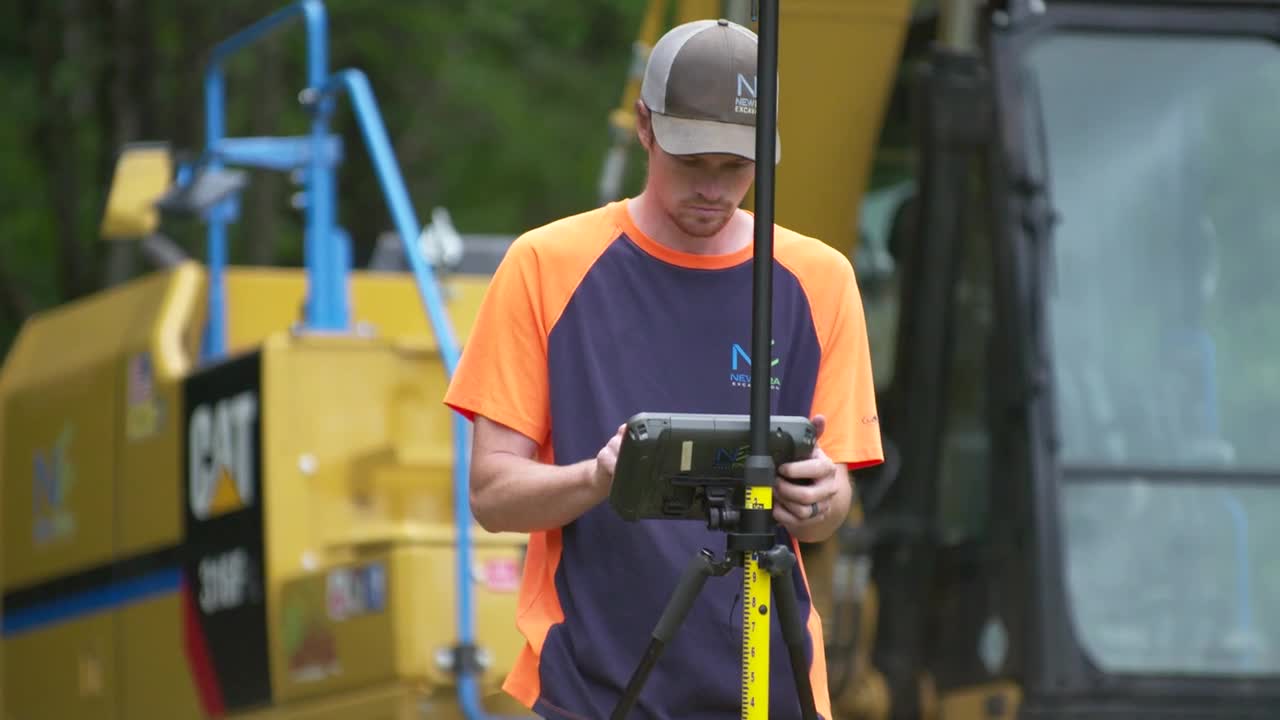Video: The Dirt Ninja digs deep into multi-purpose layout/3D guidance solution

Customer Profile: New Hampshire-based New Era Excavation is an excavation contractor that specializes in light commercial and residential projects. It is co-owned by Tom Gardocki - otherwise known as the Dirt Ninja.
Business Challenge: Evaluate the benefits of technology that performs site surveys, 3D machine guidance, in-field design and reporting
Solutions:
Benefits:
- All-in-one small site solution
- Easy transition from layout to machine guidance
- Improved productivity
- 3D opportunities
As the face of The Dirt Ninja YouTube video channel and co-owner of New Era Excavation, Tom Gardocki is well known for his passion for and interest in all things heavy equipment and the technologies that can enable these machines.
His New Hampshire-based excavation firm focuses on high-end residential and small commercial grading, excavation and utility installation in Southern New Hampshire and Northern Massachusetts. The firm invested in 2D grading systems in its earliest days, and today, most of the company’s heavy equipment is equipped with 2D and even a few full 3D systems.
“We’re a small company - just five people - so our success is all about efficiency on the jobsite,” Gardocki said. “For me, that’s where technology comes in.”
His latest foray into technology put him in the driver’s seat of a solution purpose built for site and utility contractors like him. The Trimble Siteworks Machine Guidance Module is a multi-purpose solution designed to perform a range of common activities with ease, including site surveys, 3D machine guidance, in-field design and reporting.
Involved in the product’s development with Trimble and SITECH Northeast for the last three years, Gardocki relishes his role as a tester and facilitator of the solution. Since the beginning of the year, he has taken the system from one project to another, evaluating its capabilities and potential for other heavy equipment operators.
Site Adjustments
New Era Excavation services range from general grading and yard expansions to water and sewer line trenching and full commercial site works.
“I started running heavy equipment when I was a child, so I’m very familiar with the conventional workflow that small contractors rely on,” he said.
That process often begins with a surveyor setting control. The contractor then pulls tape measures off of the surveyor’s stakes or collects this information using a laser system. When work is ready to begin, one person is on the ground checking grade, while a second person operates the machine.
“Like many others, I can remember doing this by myself, hopping in and out of the machine multiple times to verify grades and layout,” he said.
The Siteworks Machine Guidance Module is designed to combine these two activities—layout and 3D machine guidance—into one highly efficient, very accurate 3D workflow on the job site.
“Right away, I noticed that I was able to switch from layout to machine control in less than five minutes,” Gardocki explained. “What’s really nice about this system is that when I move to machine mode, the screen options look the same—I only have to learn one interface.”
His latest test bed further demonstrates the potential for improved productivity and accuracy.
ADU Advantage
New Era Excavation commonly takes on jobs building accessory dwelling units (ADU), secondary structures built on a residential property.
For one particular project, the ADU includes a 29’ x 32’ foundation, which required excavation down to eight feet. “It’s a fairly simple dig,” he said. “Later, we’ll return to connect utilities, water and sewer.”
In advance of the project start, a surveyor set the benchmarks and points for the existing foundation, and then Gardocki walked the site with the rover. He used those points to calibrate the site and design the ADU box within the Siteworks software with the assigned eight-foot depth.
“Since the GNSS smart antenna is modular, I then screw it to the top of my excavator stick and move the data collector from the rover pole to a mount in the cab of my Cat 316 excavator, and all of the data for the excavation is there,” he said. “Turn the system into machine mode and I’m good to go for 3D earthwork.”
He is quick to point out that while he has been evaluating the system with 3D models that he creates, that’s not a requirement. Many contractors outsource their designs or simply use the surveyor points and set stakes to create a very simple design. Once that’s done, the user can import the points into the software, and it will automatically calculate the finished grade. “All you have to do is establish offsets, if needed, and start digging. It's a very versatile system,” he said.
The advantages, he believes, are readily evident. “It’s great for tasks such as trenching, sidewalk and curb layout. The time and cost savings is tangible. Just from a labor standpoint, I’m 50 percent more efficient because I don’t need someone standing around with a grade rod to keep me on elevation—and it eliminates rework and rechecking because I’m always on grade with precision,” he said.
Gardocki believes the versatility, simplicity and affordability of the Siteworks module is something that even large contractors will invest in, for example to use on mini excavators to support routine tasks like trenching.
“This single system saves labor, improves accuracy – especially when pulling tape on uneven terrain – and it’s safer because nobody is standing near heavy equipment or down in the bottom of an excavation. We can get more jobs done in the course of the year with the same number of people than if we did the old way,” he said. “Even if we only completed one more job compared to previous years, we will have paid for the system. For those that don’t want to invest in a full 3D guidance system, this is a quick and easy way to transition and get some tremendous value.”